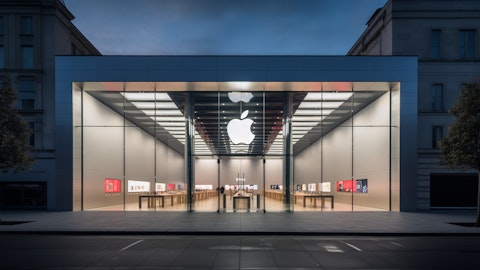And then how that translates into a margin per megawatt hour or margin percentage in the current contracts versus let’s say pre-crisis level?
Marc Spieker: Piotr thanks for the question. On the supply market, your second question, our general view is unchanged that if I look at what the value is that we can create for our customers from that we derive that across the board a 3% to 5% revenue margin is something, which you have to demand in order to make it actually a reasonable risk-adjusted business case. And that’s what we expect across the markets to materialize over time, because some markets are not there yet. Some are there. And at what stage markets will be trending rather to the upper end or the lower end is in a very specific discussion. On the other side, I would also say that in the current configuration where it is only about providing basically a commodity solution there’s also a certain limit to what margin you can ask for.
That said, we are of course working on solutions, which provide for a higher margin potential, while we are focusing on e-mobility offerings, while we are looking what we call future energy home offerings where we do see that margins — that customers are a, stickier and b, where revenue margins go up to 10%. And so our view is, kind of, strategically we are working on beyond kind of the normalization of retail margins of course in expanding the average margin, but that will require that we will also expand over time the complexity in value of our offers. On energy retail contracts terms and contracts it’s not — I understand where you’re coming from. That’s not how the business works. So it is about being very agile and receptive in the markets about what is that our customers want.
And it’s not at any point in time that our customers want three years contracts. And there are certain phases after reopening of the market where actually you have a lot of customers that are asking for a one-year contract. And then you actually better at focusing all your sales activities that’s serving that demand instead of trying to sell a three-year product which no one wants and you basically need to invest too much into acquiring the customer which they may look like nice on a commodity gross margin. But if you look at the cost to acquisition it’s actually not a great deal. And this is kind of this end-to-end optimization. It’s not only about kind of — and that’s why I understand your question comes if procurement position it’s now would be great to look it in for three years.
Well that may be the case. But if I don’t have a customer an acquisition channel open for that at reasonably attractive rates I’m not going to play that product. And this dynamic optimization of our procurement position channels, products that we put in and the relative pricing of one or three-year products to each other. It’s much more dynamic than I would just be looking at the procurement book and then say well now it will be a good time to set a three-year product.
Piotr Dzieciolowski: Okay. Thank you very much.
Iris Eveleigh: Thank you. Next question comes from James Brand, Deutsche Bank. Hi, James.
James Brand: Hi. Good results. A couple of questions. Don’t take them as gloomy questions. It happens to be ours. I want to dig into — the results are great. So the first one was on the buffer guidance. So you’re now saying €300 million buffer, but you were previously saying low to mid triple-digit millions and you had a great Q3 certainly ahead of all of our expectations and possibly ahead of your own. So maybe you could just explain the moving parts there because it would seem like there could be more upside to guidance than €300 million? And then secondly, on EIS that delivered 4% growth in EBITDA at the nine-month stage in spite of quite big investment program. So maybe you could just discuss the kind of parts there and whether you expect growth to be picking up from this level going forward? Thank you.
Marc Spieker: Yes, James great questions. On the buffer, yes, it has been another successful third quarter. I talked about that we have not implemented price decreases in our most important market Germany. So there will be a margin compression in the fourth quarter. So keep that in mind. And secondly, we are not changing our risk appetite when it comes to other factors. We talked about our approach to debt provisioning and so on. So we continue this cautious prudent stance on those elements, which we have now addressed, because we’ve been talking about those not for quarters. But we continue to do to manage all those elements with the same risk appetite or level of prudency. On the 4% EBITDA growth in our Energy Infrastructure Solutions business, the 10% annual EBITDA CAGR stays.
So underlying that growth rate, which is largely then built on our investment program continues to play out also this year. We have just two factors that are partly overlaying this. Number one is that this is not actually on growth, but we have an existing heating business in Sweden. If you look at the Swedish krona relative to the euro. So we have some FX losses on a year-over-year basis relative to our Swedish position. So that’s kind of non-operational. It doesn’t worry me. It’s underlying the same dynamics. Secondly, and we talked about that in previous quarters, we are running in this business thousands of flexible assets. And there is a certain flexibility that basically is — which doesn’t belong to our customers, but where we have an opportunity kind of to manage and monetize that flexibility.
And of course, there’s been a great wind of opportunity to do that during last year in the extreme volatility in high prices. And that’s why this part of earnings is coming off a little bit this year. So we’re making less optimization earnings on this part of the flexibility, which we have, which from an investment point of view also if you look at our IRRs, it’s just upside. So we don’t bake this and assume this in order to achieve the 7% to 10% IRRs that we have as a hurdle rate. But if it happens like last year it’s great, but then it looks kind of on a year-on-year basis like lower income, but underlying the 10% growth is intact. Our project pipeline by the way for the delivery next year is fully loaded, so basically, we have locked in the growth for next year at this stage more or less completely.
James Brand: Okay. Thank you so much.
Marc Spieker: You’re welcome.
Iris Eveleigh : Next question comes from Sam Arie from UBS. Hi, Sam.
Sam Arie : Hi, everybody. Thank you. I’ve got two questions if that’s okay. It’ relatively straightforward one just a follow-up on the prior questions about Q4 and your comment about whether something — if something bad happens in Q4. And as you also mentioned we’re kind of halfway through Q4 already. So and with that wanting any sort of detailed commentary on the quarter just a high-level question is, can you say whether something bad has already had in the first half of Q4 and you’re waiting to see if it bounces back? Or has nothing bad happened so far and we’re just being conservative about the second half of the quarter? I think that would be really helpful. And then my second question if that’s all right. I just wanted to dig into a bit of a wider topic, and I hope this isn’t too abstract, but it feels to me that we’re on the edge of a debate coming into the sector about CapEx and balance sheet and looking at next year.
And I’m just about where we are in the results so far. We had also last week. They cut their CapEx plan by a third even though they’ve got no leverage at all. People are wondering about Enel and Endesa, what the CMD will hold if they’re going to dial back CapEx a bit as well just to be cautious. Engie yesterday was kind of in the middle. They said they reconfirmed their CapEx, but they had flexibility to reduce it if they needed to. And so I’m just wondering, if as a management team this is a debate that you’re actively having at the minute Thinking about the economic uncertainties for next year, what happens if rates come off again, what happens to the economic debt. What if EBITDA is a bit lower, maybe due to timing effects and so on and CapEx is a bit higher.
I mean I suppose if I summarize, what I’m asking is are there any scenarios next year where you would imagine having to dial back with CapEx, rather than ramp it up?





